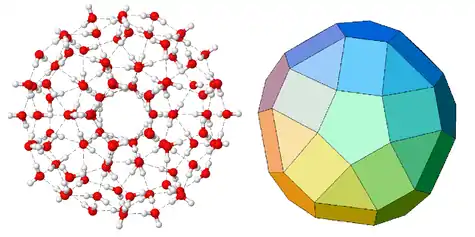
A Van der Waals molecule is a weakly bound complex of atoms or molecules held together by intermolecular attractions such as Van der Waals forces or by hydrogen bonds.[1] The name originated in the beginning of the 1970s when stable molecular clusters were regularly observed in molecular beam microwave spectroscopy.
Examples
Examples of well-studied vdW molecules are Ar2, H2-Ar, H2O-Ar, benzene-Ar, (H2O)2, and (HF)2. Others include the largest diatomic molecule He2, and LiHe.[2][3]
Supersonic beam spectroscopy
In (supersonic) molecular beams temperatures are very low (usually less than 5 K). At these low temperatures Van der Waals (vdW) molecules are stable and can be investigated by microwave, far-infrared spectroscopy and other modes of spectroscopy.[4] Also in cold equilibrium gases vdW molecules are formed, albeit in small, temperature dependent concentrations. Rotational and vibrational transitions in vdW molecules have been observed in gases, mainly by UV and IR spectroscopy.
Van der Waals molecules are usually very non-rigid and different versions are separated by low energy barriers, so that tunneling splittings, observable in far-infrared spectra, are relatively large.[5] Thus, in the far-infrared one may observe intermolecular vibrations, rotations, and tunneling motions of Van der Waals molecules. The VRT spectroscopic study of Van der Waals molecules is one of the most direct routes to the understanding of intermolecular forces.[6]
See also
- Van der Waals radius
- Van der Waals strain
- Van der Waals surface
- Category:Van der Waals molecules–articles about specific chemicals
- Researchers active in this field:
References
- ↑ Blaney, B L; Ewing, G E (1976). "Van Der Waals Molecules". Annual Review of Physical Chemistry. 27 (1): 553–584. Bibcode:1976ARPC...27..553B. doi:10.1146/annurev.pc.27.100176.003005. ISSN 0066-426X.
- ↑ Friedrich, Bretislav (8 April 2013). "A Fragile Union Between Li and He Atoms". Physics. 6: 42. Bibcode:2013PhyOJ...6...42F. doi:10.1103/Physics.6.42. hdl:11858/00-001M-0000-000E-F3C4-C.
- ↑ Joshua Jortner (8 September 2009). "Van der Waals Molecules (Donald Levy)". Advances in Chemical Physics, Photoselective Chemistry. John Wiley & Sons. pp. 323–. ISBN 978-0-470-14313-1.
- ↑ Smalley, Richard E.; Wharton, Lennard; Levy, Donald H. (1977). "Molecular optical spectroscopy with supersonic beams and jets". Accounts of Chemical Research. 10 (4): 139–145. Bibcode:1977mosw.book.....S. doi:10.1021/ar50112a006. ISSN 0001-4842. Archived from the original on September 23, 2017.
- ↑ Hutson, J M (1990). "Intermolecular Forces from the Spectroscopy of Van Der Waals Molecules". Annual Review of Physical Chemistry. 41 (1): 123–154. Bibcode:1990ARPC...41..123H. doi:10.1146/annurev.pc.41.100190.001011. ISSN 0066-426X.
- ↑ Miller, R. E. (1986). "Infrared laser photodissociation and spectroscopy of van der Waals molecules". The Journal of Physical Chemistry. 90 (15): 3301–3313. doi:10.1021/j100406a003. ISSN 0022-3654.
Further reading
- So far three special issues of Chemical Reviews have been devoted to vdW molecules: I. Vol. 88(6) (1988). II. Vol. 94(7) (1994). III. Vol. 100(11) (2000).
- Early reviews of vdW molecules: G. E. Ewing, Accounts of Chemical Research, Vol. 8, pp. 185-192, (1975): Structure and Properties of Van der Waals molecules. B. L. Blaney and G. E. Ewing, Annual Review of Physical Chemistry, Vol. 27, pp. 553-586 (1976): Van der Waals Molecules.
- About VRT spectroscopy: G. A. Blake, et al., Review Scientific Instruments, Vol. 62, p. 1693, 1701 (1991). H. Linnartz, W.L. Meerts, and M. Havenith, Chemical Physics, Vol. 193, p. 327 (1995).